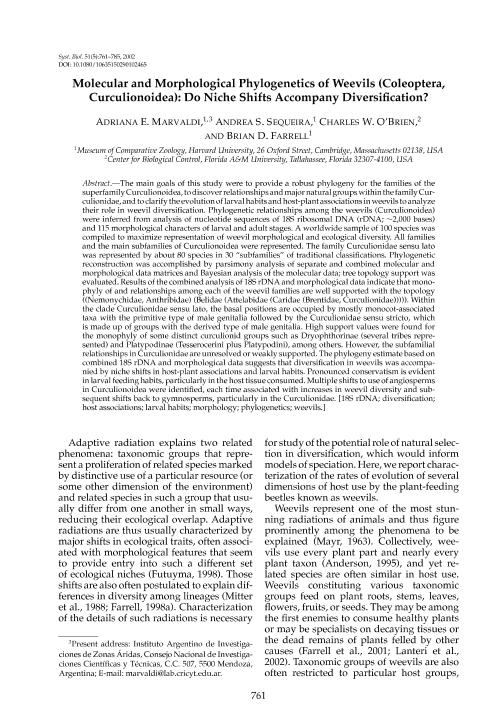Artículo
Molecular and morphological phylogenetics of weevils (Coleoptera, Curculionoidea): Do niche shifts accompany diversification?
Fecha de publicación:
12/2002
Editorial:
Oxford University Press
Revista:
Systematic Biology
ISSN:
1063-5157
Idioma:
Inglés
Tipo de recurso:
Artículo publicado
Clasificación temática:
Resumen
The main goals of this study were to provide a robust phylogeny for the families of the superfamily Curculionoidea, to discover relationships and major natural groups within the family Curculionidae, and to clarify the evolution of larval habits and host-plant associations in weevils to analyze their role in weevil diversification. Phylogenetic relationships among the weevils (Curculionoidea) were inferred from analysis of nucleotide sequences of 18S ribosomal DNA (rDNA; ∼2,000 bases) and 115 morphological characters of larval and adult stages. A worldwide sample of 100 species was compiled to maximize representation of weevil morphological and ecological diversity. All families and the main subfamilies of Curculionoidea were represented. The family Curculionidae sensu lato was represented by about 80 species in 30 "subfamilies" of traditional classifications. Phylogenetic reconstruction was accomplished by parsimony analysis of separate and combined molecular and morphological data matrices and Bayesian analysis of the molecular data; tree topology support was evaluated. Results of the combined analysis of 18S rDNA and morphological data indicate that monophyly of and relationships among each of the weevil families are well supported with the topology ((Nemonychidae, Anthribidae) (Belidae (Attelabidae (Caridae (Brentidae, Curculionidae))))). Within the clade Curculionidae sensu lato, the basal positions are occupied by mostly monocot-associated taxa with the primitive type of male genitalia followed by the Curculionidae sensu stricto, which is made up of groups with the derived type of male genitalia. High support values were found for the monophyly of some distinct curculionid groups such as Dryophthorinae (several tribes represented) and Platypodinae (Tesserocerini plus Platypodini), among others. However, the subfamilial relationships in Curculionidae are unresolved or weakly supported. The phylogeny estimate based on combined 18S rDNA and morphological data suggests that diversification in weevils was accompanied by niche shifts in host-plant associations and larval habits. Pronounced conservatism is evident in larval feeding habits, particularly in the host tissue consumed. Multiple shifts to use of angiosperms in Curculionoidea were identified, each time associated with increases in weevil diversity and subsequent shifts back to gymnosperms, particularly in the Curculionidae.
Archivos asociados
Licencia
Identificadores
Colecciones
Articulos(IADIZA)
Articulos de INST. ARG DE INVEST. DE LAS ZONAS ARIDAS
Articulos de INST. ARG DE INVEST. DE LAS ZONAS ARIDAS
Citación
Marvaldi, Adriana; Sequeira, Andrea; O'Brien, Charles W.; Farrel, Brian D.; Molecular and morphological phylogenetics of weevils (Coleoptera, Curculionoidea): Do niche shifts accompany diversification?; Oxford University Press; Systematic Biology; 51; 5; 12-2002; 761-785
Compartir
Altmétricas




